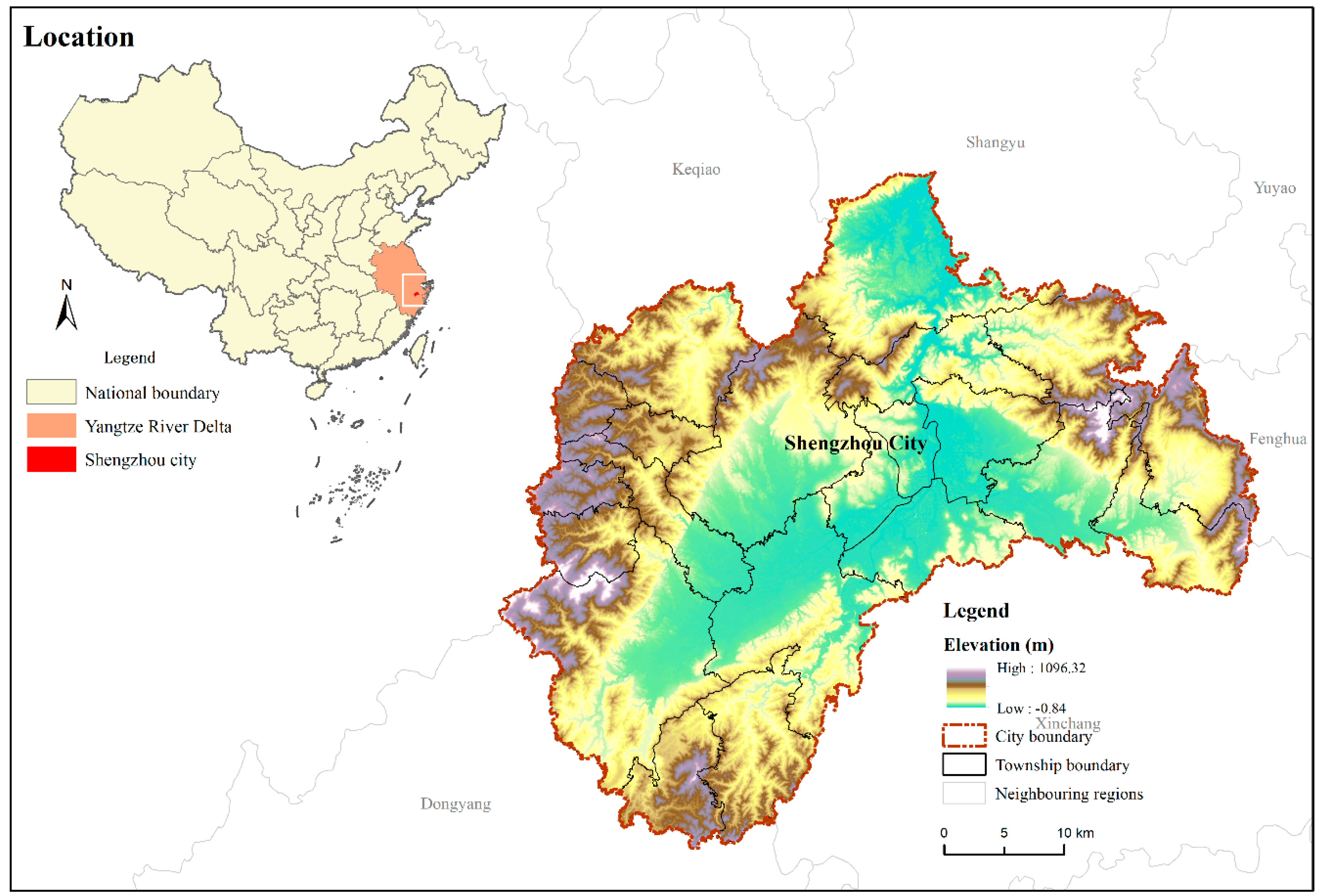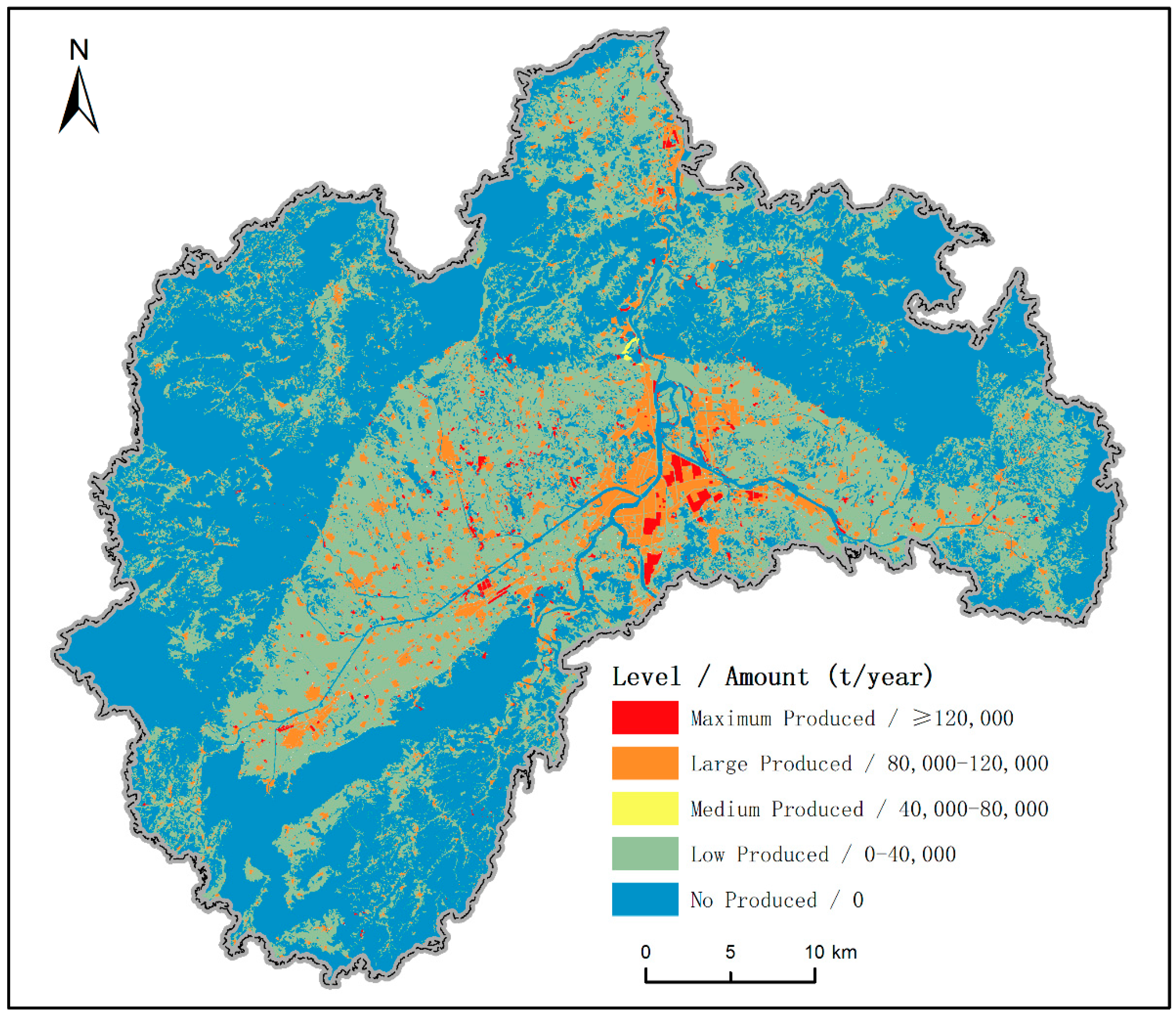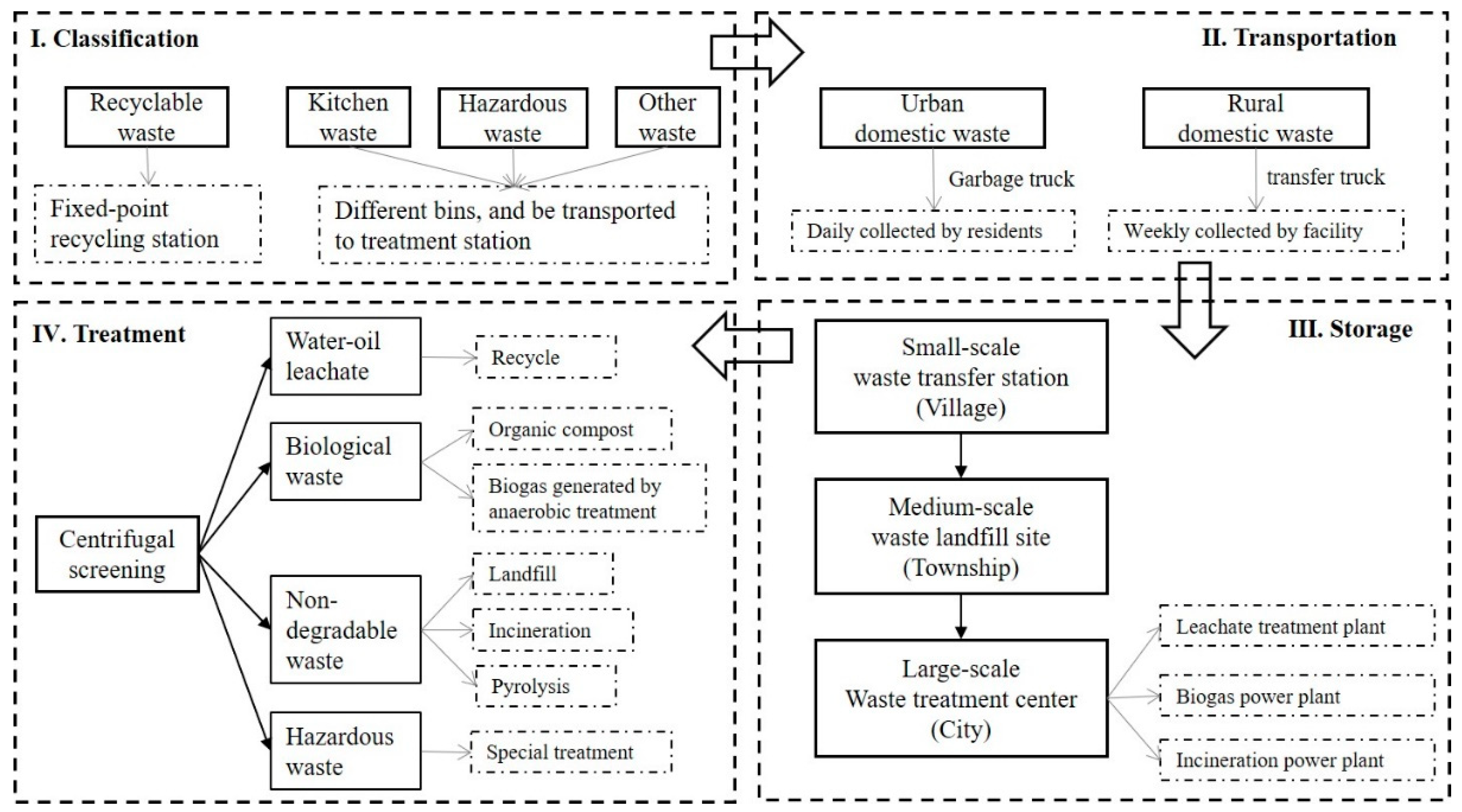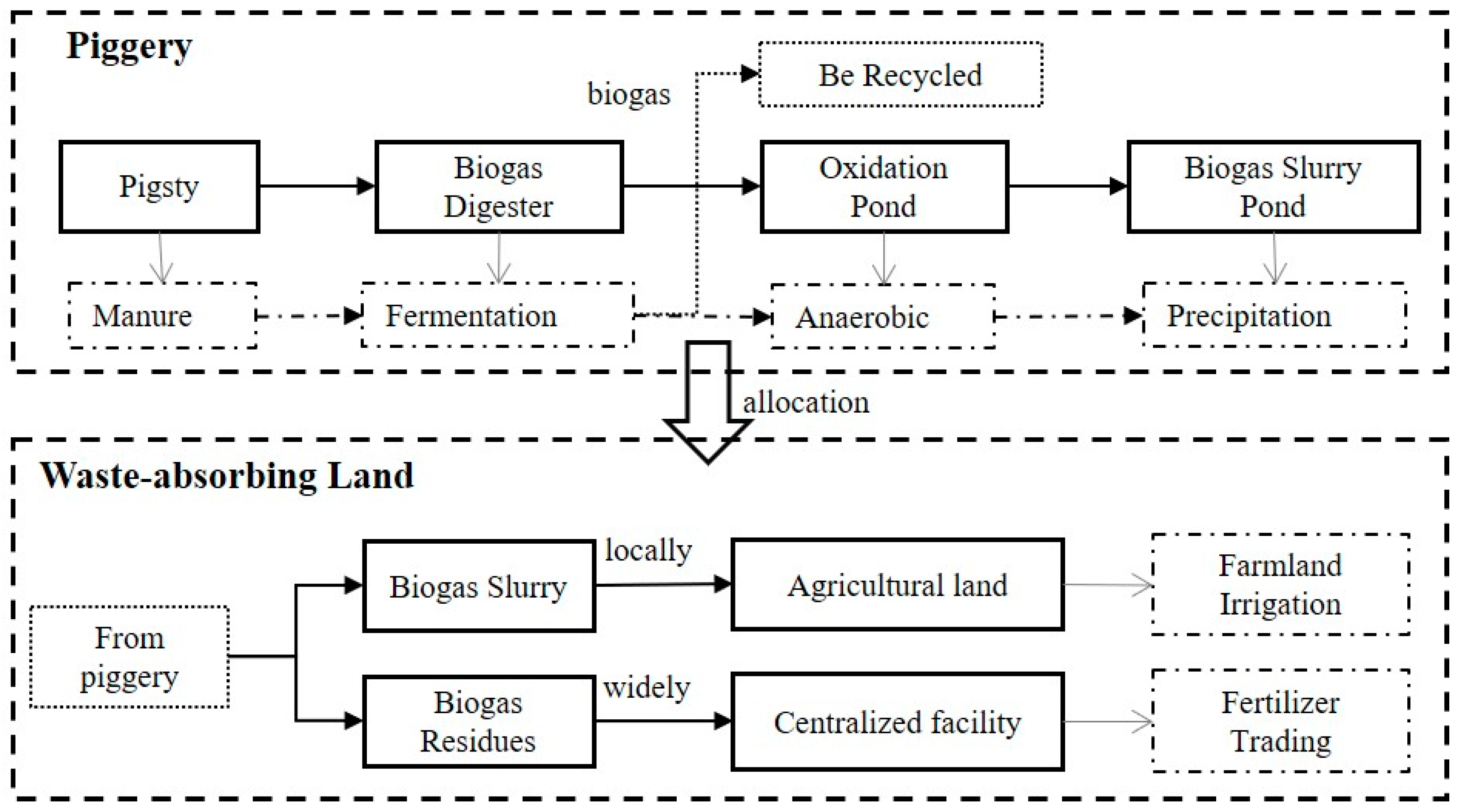Spatial Classification and Environmental Treatment Protocols of Solid Waste Sources—A Case Study of Shengzhou, China
Abstract
1. Introduction
2. Theory and Methods
2.1. Territorial Function Theory and SWSs
2.2. Weighted Sum Method
2.3. Study Area and Data Sources
2.3.1. Study Area
2.3.2. Data Sources
3. Results
3.1. Calculation Results of Solid Waste Produced
3.2. Spatial Classification and Distribution of SWSs
3.3. Environmental Treatment Protocol of Key SWSs
4. Discussion
5. Conclusions
Author Contributions
Funding
Acknowledgments
Conflicts of Interest
Appendix A
| Interviewer: Yufan Chen, Yong Xu, Kaiyong Wang | |
| Interviewee: Ecology and Environment Bureau, Planning and Natural Resources Bureau, Development and Reform Bureau, Economy and Information Technology Bureau, Science and Technology Bureau, Housing and Urban-Rural Development Bureau, Water Authority Bureau, Market Supervision and Administration Bureau, Comprehensive Law-Enforcing of City Administration Bureau, Civil Affairs Bureau, Transport Bureau, Agriculture and Rural Affairs Bureau, Statistics Bureau, Water Group | |
| Date: June 19, 2019 (for 3 h) | |
| Participants: 14 departments, 40 people | |
| Issue 1: Land resource and city planning | Interviewee: Ecology and Environment Bureau, Planning and Natural Resources Bureau, Civil Affairs Bureau, Transport Bureau |
| Questions: 1. Is there a shortage of land resources in Shengzhou? 2. Is there a contradiction between urban development space, agricultural space and ecological space? 3. How to set up the administrative division system of Shengzhou? 4. What is the jurisdiction of towns and cities of Shengzhou? 5. How to arrange the transportation space of Shengzhou? | |
| Issue 2: Rural environmental treatment | Interviewee: Ecology and Environment Bureau, Planning and Natural Resources Bureau, Comprehensive Law-Enforcing of City Administration Bureau, Agriculture and Rural Affairs Bureau, Water Authority Bureau |
| Questions: 1. How to recover agricultural pesticides, fertilizers and mulch, especially how to deal with the hazardous wastes? 2. What is the control mode of rural sewage treatments? 3. Whether large-scale groundwater pollution is caused in a rural area after the use of piggeries with waste-absorbing land? 4. How to deal with the straw waste? 5. Whether the mode of rural production changes to the reduction of investment? 6. How about the progress on the construction of beautiful countryside? 7. How to promote the transformation of pollution control facilities in rural aquaculture? 8. How many pig farms are there in Shengzhou and how to deal with waste produced? | |
| Issue 3: Urban environmental treatment | Interviewee: Ecology and Environment Bureau, Housing and Urban-Rural Development Bureau, Comprehensive Law-Enforcing of City Administration Bureau |
| Questions: 1. Whether the use of coal in the catering industry causes environmental pollution, and how to deal with and supervise the residual coal and kitchen waste? 2. Under the background of future community construction, how to deal with community domestic waste? | |
| Issue 4: Industrial development and industrial zone environmental treatment | Interviewee: Development and Reform Bureau, Economy and Information Technology Bureau, Science and Technology Bureau, Market Supervision and Administration Bureau, Statistics Bureau |
| Questions: 1. What is the industrial planning of Shengzhou? (advantageous industry, characteristic industry, polluting industry, etc.) 2. When the enterprise registers, what are the requirements for environmental protection? 3. Whether it has formulated a negative list of enterprises? 4. What is the construction plan of the industrial zone in Shengzhou? (scale, number, requirement of entering the zone, treatment process of waste generated in the zone, etc.) 5. How to deal with production waste if small factories or workshops fail to enter the zone? | |
| Issue 5: Sewage control and treatment | Interviewee: Water Authority Bureau, Water Group |
| Questions: 1. What is the sewage control mode in Shengzhou? 2. How about the water quality of Shengzhou as a water conservation area? 3. What is the construction plan of sewage treatment plants in Shengzhou? (scale, number, distribution) 4. What is the treatment process of sewage treatment plant and how to deal with the residual sludge? | |
| Date: June 17, 2019 | Region: Ganlin town, Shengzhou |
| Route: Domestic sewage treatment terminal project of Huangshengtang village – Rural pig farms – Sewage treatment plant of Ganlin town – Zhejiang Yiren Electric Appliance Co, Ltd. – Shengzhou municipal landfill (leachate treatment plant, biogas plant, incineration plant under construction) – Shengxin sewage treatment plant The purpose of this route is to investigate the construction of rural environmental treatment facilities and pollutant treatment process in Shengzhou, as well as the operation of centralized treatment facilities such as landfill and sewage treatment plant. | |
| Date: June 18, 2019 | Region: Shengzhou Economic Development Zone, Shengzhou High-Tech Development Zone |
| Route: Zhejiang Tianfang Technology Co., Ltd. -- Babe Group (representative of neckwear industry) – Lutong Cement Products Co., Ltd. – Zhejiang Yitian Intelligent Kitchen Co., Ltd. – Zhejiang Zhongyi Machinery Co., Ltd. – Kangli Machinery Co., Ltd. – Feiyi Agricultural Leisure Town The purpose of this route is to examine the construction of industrial zones in Shengzhou, including two parts: ETDC and HIDZ, with an emphasis on understanding the advantageous industries in Shengzhou and the waste treatment process in the industrial zones. | |
| Date: June 20, 2019 | Region: Jinting town, Chongren town, Changle town, Shengzhou |
| Route: Jinting Temple – Hot Spring Resort – Nanshan Reservoir in Changle town – Zhejiang Lvcheng Agricultural Development Co., Ltd. The purpose of this route is to investigate the beautiful countryside construction, irrigation facilities and water source protection measure in Shengzhou. | |
References
- Yao, T.; Cao, X.; Wu, Z.Y. On the Treatment and Resource Utilization of General Industrial Solid Waste. Econ. Probl. 2019, 9, 53–61. [Google Scholar]
- Feng, X. Present Situation and Countermeasure of Comprehensive Treatment Technology of Solid Waste. China Resour. Compr. Util. 2019, 37, 50–52. [Google Scholar]
- Sun, Y.H. Analysis on the development trend of solid waste recycling. Inn. Mong. Environ. Sci. 2019, 31, 146. [Google Scholar]
- Pariatamby, A. Municipal Solid Waste Management in Asia and the Pacific Islands; Springer: Singapore, 2017. [Google Scholar]
- Gu, B.; Jiang, S.; Wang, H.; Wang, Z.; Jia, R.; Yang, J.; He, S.; Cheng, R. Characterization, quantification and management of China’s municipal solid waste in spatiotemporal distributions: A review. Waste Manag. 2016, 61, 67–77. [Google Scholar] [CrossRef]
- Khan, D.; Kumar, A.; Samadder, S.R. Impact of socioeconomic status on municipal solid waste generation rate. Waste Manag. 2016, 49, 15–25. [Google Scholar] [CrossRef]
- Han, X.; Hu, C.; Lin, L. A study on the impact of China’s urbanization on the quantity of municipal solid waste produced. Waste Manag. Res. 2020, 38, 184–192. [Google Scholar] [CrossRef]
- Koroneos, C.J.; Nanaki, E.A. Integrated solid waste management and energy production-a life cycle assessment approach: The case study of the city of Thessaloniki. J. Clean. Prod. 2012, 27, 141–150. [Google Scholar] [CrossRef]
- Jara-Samaniego, J.; Pérez-Murcia, M.D.; Bustamante, M.A.; Perez-Espinosa, A.; Lopez, M.; Lopez-Lluch, D.B.; Gavilanes-Teran, I.; Moral, R. Composting as sustainable strategy for municipal solid waste management in the Chimborazo Region, Ecuador: Suitability of the obtained composts for seedling production. J. Clean. Prod. 2017, 141, 1349–1358. [Google Scholar] [CrossRef]
- Sipra, A.T.; Gao, N.; Sarwar, F. Municipal solid waste (MSW) pyrolysis for bio-fuel production: A review of effects of MSW components and catalysts. Fuel Process. Technol. 2018, 175, 131–147. [Google Scholar] [CrossRef]
- Meza, J.K.S.; Orjuela-Yepes, D.; Rodrigo-Ilarri, J.; Cassiraga, E. Predictive analysis of urban waste generation for the city of Bogota, Colombia, through the implementation of decision trees-based machine learning, support vector machines and artificial neural networks. Heliyon 2019, 5, e02810. [Google Scholar] [CrossRef]
- Mir, M.A.; Ghazvinei, P.T.; Sulaiman, N.M.N.; Basri, N.E.A.; Saheri, S.; Mahmood, N.Z.; Jahan, A.; Begum, R.A.; Aghamohammadi, N. Application of TOPSIS and VIKOR improved versions in a multi criteria decision analysis to develop an optimized municipal solid waste management model. J. Environ. Manag. 2016, 166, 109–115. [Google Scholar]
- Morero, B.; Vicentin, R.; Campanella, E.A. Assessment of biogas production in Argentina from co-digestion of sludge and municipal solid waste. Waste Manag. 2017, 61, 195–205. [Google Scholar] [CrossRef] [PubMed]
- Zhang, Y.X.; Hu, J. Study on legislation of prevention and control of rural solid waste pollution in China. Agric. Econ. 2014, 7, 21–23. [Google Scholar]
- Zhou, K.; Gao, C.X. Legal Regulation of Recycle Economy in Prevention and Control of Solid Waste Pollution in Rural Areas. Environ. Prot. 2017, 45, 8–12. [Google Scholar]
- Guan, H.; Qi, W.N.; Wang, S.Z.; Zhang, Y. Game Analysis for Environmental Pollution Treatment between Enterprises and Governments. Econ. Manag. 2014, 6, 72–75. [Google Scholar]
- Liu, S.X.; Zhu, Y.M.; Du, K.Q. Three-player game analysis among enterprise, government and Non-government Organization in environmental pollution abatement. Environ. Pollut. Control 2017, 39, 574–577. [Google Scholar]
- Gu, Y.K.; Wang, H.Z. Research progress of environmental pollution by solid waste landfill. Technol. Wind 2012, 8, 215. [Google Scholar]
- Wang, H.J.; Zeng, D.F.; Chen, F.X.; Sun, Q. A New Concept of Pollutant Sources and Line of Demarcation Among Road Pollutant Sources. Environ. Prot. Transp. 1999, 1, 31–33. [Google Scholar]
- Wu, C.J. On the research core of geography--the man-earth areal system. Econ. Geogr. 1991, 3, 7–12. [Google Scholar]
- Motesharrei, S.; Rivas, J.; Kalnay, E.; Asrar, G.R.; Busalacchi, A.J.; Cahalan, R.F.; Cane, M.A.; Colwell, R.R.; Feng, K.S.; Franklin, R.S.; et al. Modeling sustainability: Population, inequality, consumption, and bidirectional coupling of the Earth and Human Systems. Natl. Sci. Rev. 2016, 3, 470–494. [Google Scholar] [CrossRef]
- Sheng, K.R.; Fan, J. The Formation Mechanism of Regional Function: An Analysis Based on the Theory of Man-Earth Areal System. Econ. Geogr. 2018, 38, 11–19. [Google Scholar]
- Soini, K. Exploring human dimensions of multifunctional landscapes through mapping and map-making. Landsc. Urban Plan. 2001, 57, 225–239. [Google Scholar] [CrossRef]
- Fan, J. Spatial organization pathway for territorial function-structure: Discussion on implementation of major function zoning strategy in territorial spatial planning. Geogr. Res. 2019, 38, 2373–2387. [Google Scholar]
- Zhou, K.; Fan, J. Regional disparity of environmental pollution source and its socio-economic influencing factors: Based on the cross-section data of 339 cities at prefecture level or above in china. Acta Geogr. Sin. 2016, 71, 1911–1925. [Google Scholar]
- Bartkowiak-Bakun, N. The diversity of socioeconomic development of rural areas in Poland in the western borderland and the problem of post-state farm localities. Work. Pap. 2017, 8, 417–432. [Google Scholar] [CrossRef]
- Deng, Q.; Wang, Q.; Huang, Q.F. Application of GM (1,1) in Forecasting Quantity of Industrial Solid Waste. Environ. Sci. Technol. 2012, 35, 180–183. [Google Scholar]
- Li, X. Research on Regional Industrial Solid Waste Comprehensive Utilization Ability Influencing Factors Based on Panel Data. Int. J. Technol. Manag. 2013, 89–92. [Google Scholar]
- Meza, J.K.S.; Rodrigo-Ilaari, J.; Hernadez, C.P.R.; Rodrigo-Clavero, M.E. Analytical methodology for the identification of critical zones on the generation of solid waste in large urban areas. Int. J. Environ. Res. Public Health 2020, 17, 1196. [Google Scholar] [CrossRef]
- National Bureau of Statistics of China. China Statistical Yearbook; China Statistical Publishing House: Beijing, China, 2018. [Google Scholar]
- Shengzhou Statistics Bureau. National Economic and Social Development Statistical Communique of Shengzhou. Available online: http://www.szzj.gov.cn/art/2020/4/8/art_1530083_42511090.html (accessed on 8 April 2020).
- Shaoxing Municipal Bureau of Statistics. Shaoxing Statistical Yearbook. Available online: http://tjj.sx.gov.cn/art/2019/12/31/art_1489207_41684038.html (accessed on 31 December 2019).
- Shengzhou Environmental Protection Monitoring Station. Shengzhou Environmental Quality Report. Available online: http://www.szzj.gov.cn/art/2019/6/6/art_1562830_34507271.html (accessed on 6 June 2019).
- Yang, N.; Shao, L.M.; He, P.J. Study on the moisture content and its features for municipal solid waste fractions in China. China Environ. Sci. 2018, 38, 1033–1038. [Google Scholar]
- Dong, X.D.; Zhang, Y.L. Investigation and analysis of physicochemical characteristics of municipal solid waste in Shanghai. Environ. Sanit. Eng. 2016, 24, 18–21. [Google Scholar]
- Wei, H.J.; Wang, R.S. Analysis and prediction on biological sludge yield from Bailonggang Wastewater Treatment Plant. Water Wastewater Eng. 2011, 37, 27–30. [Google Scholar]
- Fan, Y. Analysis of present situation of treatment and disposal for municipal sewage sludge and argumentation for the engineering proposal. Water Purif. Technol. 2018, 37, 93–96. [Google Scholar]
- Paleologos, E.K.; Caratelli, P.; Amrousi, M. Waste-to-energy: An opportunity for a new industrial typology in Abu Dhabi. Renew. Sustain. Energy Rev. 2016, 55, 1260–1266. [Google Scholar] [CrossRef]
- Dong, X.; Zhu, Z.; Li, L.; Liu, J.; Hampshire, S.; Dong, Y.; Zhu, L. Feasible recycling of industrial waste coal fly ash for preparation of anorthite-cordierite based porous ceramic membrane supports with addition of dolomite. J. Eur. Ceram. Soc. 2016, 36, 1059–1071. [Google Scholar]
- Mia, S.; Uddin, M.E.; Kader, M.A.; Ahsan, A.; Mannan, M.A.; Hossain, M.M.; Solaiman, Z.M. Pyrolysis and co-composting of municipal organic waste in Bangladesh: A quantitative estimate of recyclable nutrients, greenhouse gas emissions, and economic benefits. Waste Manag. 2018, 75, 503–513. [Google Scholar] [CrossRef]
- Wu, Y.H.; Hu, Z.Y.; Yang, L.Z. Integrated Technology to Control Non-point Pollution in Resident-farmland Areas of Dianchi Lake Watershed,China. Ecol. Sci. 2008, 27, 346–350. [Google Scholar]
- Qian, H.Y.; Chen, K.; Yan, Y.P. Design and application of bio-ecological technology for wastewater treatment in a small pig farm. Chin. Agric. Sci. Bull. 2018, 34, 62–68. [Google Scholar]
- Zheng, X.; Fan, J.; Zhou, J.; He, Y. Effects of Combined Application of Biogas Slurry and Chemical Fertilizer on Soil Nutrients and Peanut Yield in Upland Red Soil. Acta Pedol. Sin. 2016, 53, 675–684. [Google Scholar]
- Li, Y.H.; Liu, Y.; Liu, M.Y.; Liu, M.; Li, X.; Zhou, J.; Li, Y.; Wu, J. Integrated benefit analysis of a combined constructed wetland using rice-straw and Myriophyllum elatinoides to treat swine wastewater. Res. Agric. Mod. 2018, 39, 325–334. [Google Scholar]
- Liu, X.Z.; Shi, H.Q.; Chen, F.G. Effect assessment of constructed wetlands on the treatment of large-scale swine wastewater. Ecol. Environ. Sci. 2018, 27, 2110–2116. [Google Scholar]
- Sapuric, Z.; Dimitrovski, D.; Dimitrovski, M.; Ivanovski, F. Medical waste incineration in Skopje: Regulation and standards. J. Environ. Prot. Ecol. 2016, 17, 805–812. [Google Scholar]
- Kong, D.F. Research on the identification of medical waste disposal and emergency management. Value Eng. 2016, 35, 218–219. [Google Scholar]




| Classes | Subclasses | Types |
|---|---|---|
| Production space | Industrial and mining production space | Mining area |
| Industrial production site | ||
| Agricultural production space | Cultivated land | |
| Garden plot | ||
| Livestock farm | ||
| Special production space | Landfill | |
| Sewage treatment plant | ||
| Living space | Urban settlement | |
| Rural settlement | ||
| Transportation land | ||
| Ecological space | Forest land | |
| Grassland | ||
| Water area | ||
| Bare land |
| SWS (Type-Level) | Land Area (hm2) | Total Produced Amount (Quantitative/Qualitative) (10,000 t) | Types | |
|---|---|---|---|---|
| Domestic Waste | Industrial Solid Waste | |||
| Urban settlement | 3155.25 | 11.10 | 11.10 | 0.00 |
| Rural settlement | 8328.93 | 8.67 | 8.67 | 0.00 |
| Industrial production site | 656.71 | 12.73 | 1.79 | 10.94 |
| Mining area | 654.02 | higher than industrial production site | ||
| Transportation land | 1338.05 | less than urban and rural settlement | ||
| Cultivated land | 48,751.01 | 2.75 | 0.00 | 0.00 |
| Garden plot | 17,872.78 | 1.11 | 0.00 | 0.00 |
| Livestock farm | 116.32 | 13.21 | 0.00 | 0.00 |
| Sewage treatment plant | 22.01 | 6.68 | 0.00 | 0.00 |
| Landfill | 18.86 | 5.85 | 5.85 | 0.00 |
| Others | 98,971.77 | 0.00 | 0.00 | 0.00 |
| Composition | Organic Waste | Inorganic Waste | Recyclable Waste | ||||||
|---|---|---|---|---|---|---|---|---|---|
| kitchen Waste | Lime-Soil | Tile | Paper | Plastic | Fabric | Glass | Metal | Others | |
| Proportion (%) | 56.44 | 27.38 | 1.04 | 4.88 | 7.53 | 1.72 | 0.80 | 0.34 | 0.93 |
© 2020 by the authors. Licensee MDPI, Basel, Switzerland. This article is an open access article distributed under the terms and conditions of the Creative Commons Attribution (CC BY) license (http://creativecommons.org/licenses/by/4.0/).
Share and Cite
Chen, Y.; Xu, Y.; Wang, K. Spatial Classification and Environmental Treatment Protocols of Solid Waste Sources—A Case Study of Shengzhou, China. Sustainability 2020, 12, 3594. https://doi.org/10.3390/su12093594
Chen Y, Xu Y, Wang K. Spatial Classification and Environmental Treatment Protocols of Solid Waste Sources—A Case Study of Shengzhou, China. Sustainability. 2020; 12(9):3594. https://doi.org/10.3390/su12093594
Chicago/Turabian StyleChen, Yufan, Yong Xu, and Kaiyong Wang. 2020. "Spatial Classification and Environmental Treatment Protocols of Solid Waste Sources—A Case Study of Shengzhou, China" Sustainability 12, no. 9: 3594. https://doi.org/10.3390/su12093594
APA StyleChen, Y., Xu, Y., & Wang, K. (2020). Spatial Classification and Environmental Treatment Protocols of Solid Waste Sources—A Case Study of Shengzhou, China. Sustainability, 12(9), 3594. https://doi.org/10.3390/su12093594






